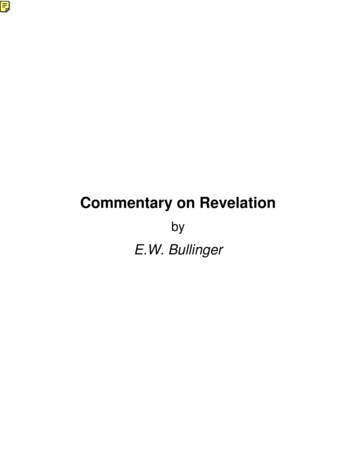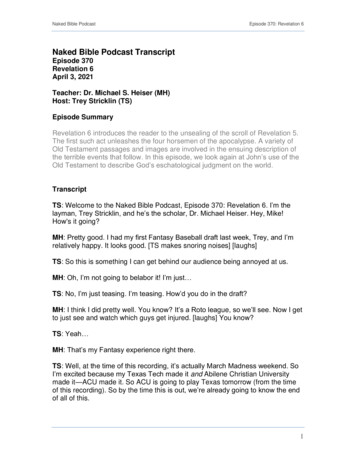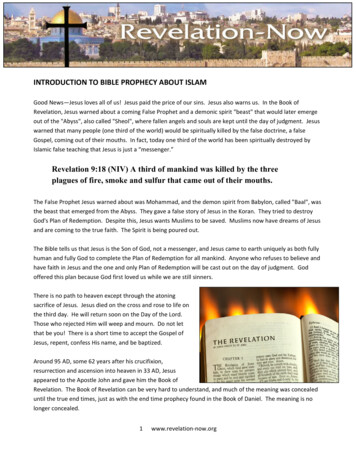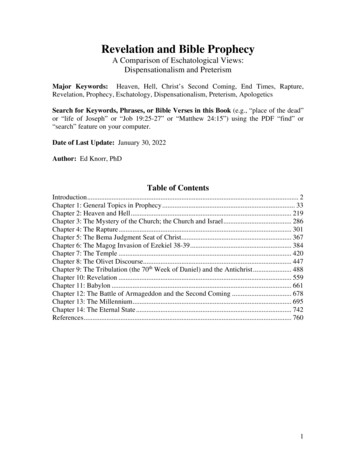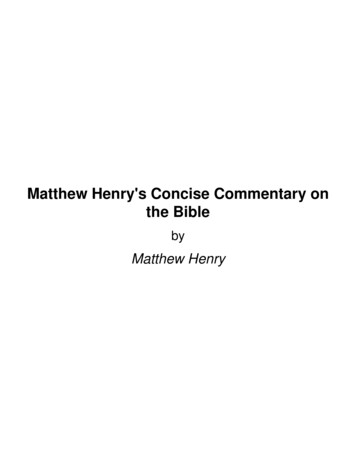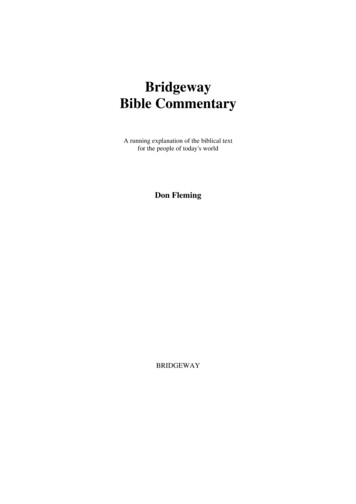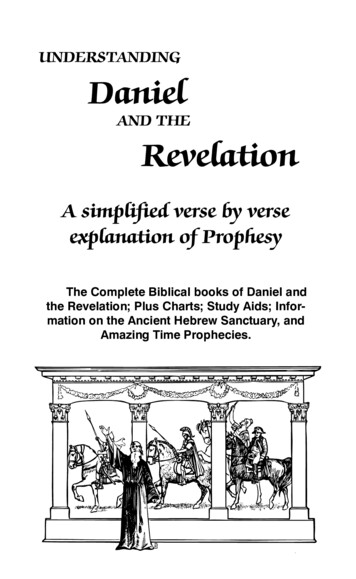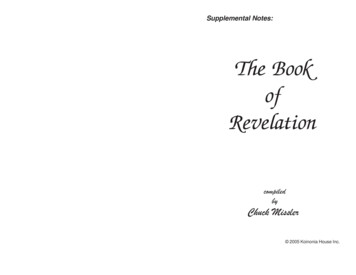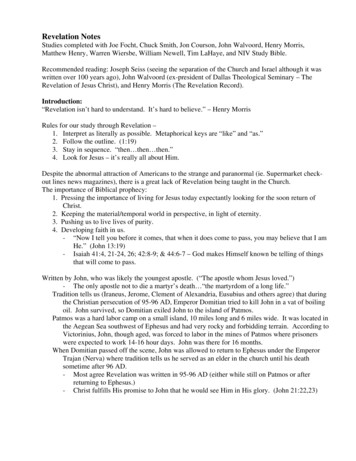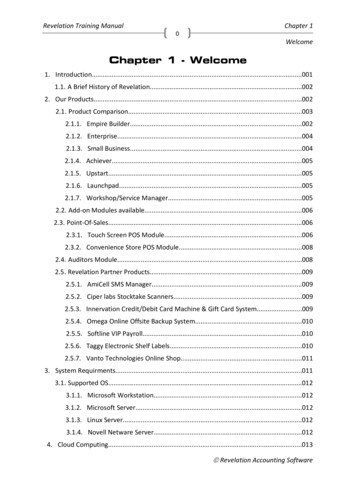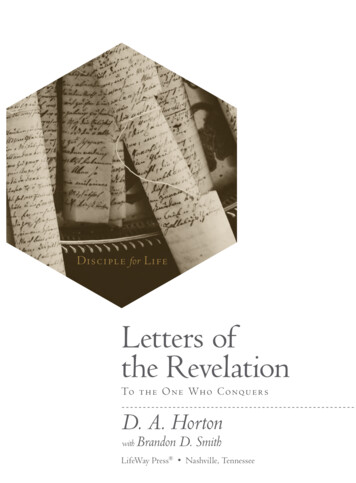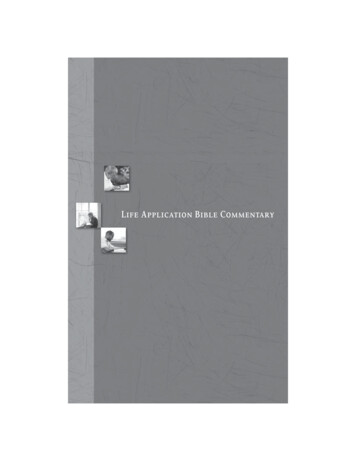
Transcription
Life Application Bible CommentaryRevelation.indd i2/23/2009 2:18:59 PM
Revelation.indd ii2/23/2009 2:20:23 PM
lifeApplication Bible CommentaryREVELATIONTYNDALE HOUSEPUBLISHERS, INC.CAROL STREAM,ILLINOISRevelation.indd iiiBruce B. Barton, D.Min.Linda Chaffee TaylorNeil Wilson, M.R.E.David R. Veerman, M.Div.GENERAL EDITOR: Grant Osborne, Ph.D.SERIES EDITOR: Philip W. Comfort, D.Litt.et Phil.2/23/2009 2:20:24 PM
Visit Tyndale’s exciting Web site at www.tyndale.comLife Application Bible Commentary: RevelationCopyright 2000 by The Livingstone Corporation. All rights reserved.Contributing Editors: James C. Galvin, Ed.D., and Ronald A. BeersCover photograph of bridge and path copyright by Alyn Stafford / iStockphoto.All rights reserved.Cover photographs of woman with a laptop and man holding a pen copyright byDan Wilton / iStockphoto. All rights reserved.Cover photo of man reading copyright by Ronnie Comeau / iStockphoto. All rightsreserved.Interior illustration of gemstone copyright 2004 by Tracy Walker. All rights reserved.Scripture quotations marked NIV are taken from the Holy Bible, New InternationalVersion . NIV . Copyright 1973, 1978, 1984 by International Bible Society. Used bypermission of Zondervan. All rights reserved.Scripture quotations marked NKJV are taken from the New King James Version.Copyright 1979, 1980, 1982 by Thomas Nelson, Inc. Used by permission. All rightsreserved.Scripture quotations marked NRSV are taken from the New Revised StandardVersion of the Bible, copyright 1989, Division of Christian Education of theNational Council of the Churches of Christ in the United States of America. Usedby permission. All rights reserved.(No citation is given for Scripture text that is exactly the same wording in all threeversions—NIV, NKJV, and NRSV.)Scripture quotations marked KJV are taken from the Holy Bible, King James Version.Scripture quotations marked NLT are taken from the Holy Bible, New LivingTranslation, copyright 1996. Used by permission of Tyndale House Publishers, Inc.,Carol Stream, Illinois 60188. All rights reserved.TYNDALE, Life Application, New Living Translation, NLT, and Tyndale’s quill logo areregistered trademarks of Tyndale House Publishers, Inc.Library of Congress Cataloging-in-Publication dataRevelation / Bruce B. Barton—[et al.]; general editor, Grant Osborne.p.cm.—(Life application Bible commentary)Includes bibliographical references and index.ISBN 978-0-8423-2874-6 (sc : alk. paper)1.Bible. N.T. Revelation—Commentaries. I.Barton, Bruce B. II.Osborne, Grant R.III.SeriesBS2825.3.R45 2000228'.077—dc2199-048751Printed in the United States of America1414Revelation.indd iv13131212111110100992/23/2009 2:20:24 PM
thorDate and SettingAudiencePurposeInterpretationA Quick Journey throughRevelationxxii Messagexxv Vital Statisticsxxv 9225237251267Revelation 1Revelation 2Revelation 3Revelation 4Revelation 5Revelation 6Revelation 7Revelation 8Revelation 9Revelation 10Revelation 11Revelation 12Revelation 13Revelation 14Revelation 15Revelation 16Revelation 17Revelation 18:1–19:5Revelation 19:6-21Revelation 20Revelation 21Revelation 22279 Bibliography281 IndexRevelation.indd v2/23/2009 2:20:24 PM
Revelation.indd vi2/23/2009 2:20:24 PM
Revelation.indd vii2/23/2009 2:20:25 PM
FOREWORDThe Life Application Bible Commentary series provides verseby-verse explanation, background, and application for everyverse in the New Testament. In addition, it gives personal help,teaching notes, and sermon ideas that will address needs, answerquestions, and provide insight for applying the Word of God tolife today. The content is highlighted so that particular versesand phrases are easy to find.Each volume contains three sections: introduction, commentary, and reference. The introduction includes an overviewof the book, the book’s historical context, a time line, culturalbackground information, major themes, an overview map, andan explanation about the author and audience.The commentary section includes running commentary onthe Bible text with reference to several modern versions, especially the New International Version, the New Revised StandardVersion, and the New Living Translation, accompanied by lifeapplications interspersed throughout. Additional elements includecharts, diagrams, maps, and illustrations. There are also insightfulquotes from church leaders and theologians such as John Calvin,Martin Luther, John Wesley, and A. W. Tozer. These features aredesigned to help you quickly grasp the biblical information andbe prepared to communicate it to others. The reference sectionincludes an index and a bibliography.Revelation.indd ix2/23/2009 2:20:27 PM
INTRODUCTIONHollywood studios produce spectacular displays for movietheater entertainment. With computer-generated images and otherhigh-tech tricks, movies present special effects that seem almostbeyond comprehension. Aliens and dinosaurs come to life; explorers travel faster than light; animals and trees dance, sing, and talk.Viewers marvel at the show, then return to reality as the credits roll.That’s great entertainment. But we know it’s not real. Nowflip to the back of your Bible, to the last book—Revelation. Asyou read, you soon will become immersed in a fantastic displayof sights, sounds, colors, and images. If you feel overwhelmedand amazed, think of what the original witness to these events,John, must have felt as vision after vision assaulted his senses.No adjectives can adequately describe this multimedia show.Trumpets, thrones, lightning, thunder, lampstands, awful creatures, millions of majestic angels, a mighty chorus, fiery horses,plagues, terrible bowls . . . one scene follows another, movingsteadily and decisively toward the ultimate finale.This is a story of martyrs and battles, of demons and angels,of things to come. Revelation reveals God and his plan for thefuture. And it’s true.AUTHORJohn the apostle, son of Zebedee and Salome and younger brotherof James.In a book filled with obscure images and vague allusions,one thing comes through loud and clear: the name of the author.At the very beginning, Revelation identifies its source: “This isa revelation from Jesus Christ . . . sent to God’s servant John”(1:1 NLT). The statement asserts that Jesus Christ himself gavethis revelation to a man named John.The early church fathers—including Justin Martyr, Irenaeus,and Hippolytus—uniformly identified this John as the apostle ofthe same name, the one who abandoned his father’s fishing netsto follow Jesus (Matthew 4:21-22). It is clear from the Gospelsthat the apostle John was very close to Jesus. Jesus singled outRevelation.indd xi2/23/2009 2:20:27 PM
REVELATIONxiiPeter, James, and John to accompany him to Jairus’s home to witness the resurrection of Jairus’s daughter (Mark 5:37-43). Then,on two separate occasions, Jesus asked the three men to go awaywith him to a secluded place to spend time in prayer. At the firstof these occasions, John witnessed the dazzling transfiguration ofJesus as he was joined by two heavenly guests, Moses and Elijah(Luke 9:28-31). The second occasion came during that agonizingnight Jesus spent in the Garden of Gethsemane before his arrest(Matthew 26:36-38). John also helped make preparations for theLast Supper (Luke 22:8). What a great privilege to have beensuch a close confidant of the Lord Jesus himself!Apparently, John’s proximity to the Master made him quitebold. He didn’t shrink from asking Jesus if he could sit in a placeof honor in the coming kingdom (Mark 10:35-37). John evenoffered to call down fire from heaven to wipe out a Samaritanvillage that had rejected Jesus (Luke 9:54-55). In each case, Jesusreined in the misplaced enthusiasm of this “Son of Thunder”(see Mark 3:17). Yet John’s clear loyalty to his Lord and Saviorshould be admired. His love for Jesus motivated him to stay closein the darkest hour. On the day of Jesus’ crucifixion, John stood atthe foot of the cross, where Jesus entrusted him with the care ofJesus’ earthly mother (John 19:26-27). No wonder John humblydescribed himself as the disciple Jesus loved (John 13:23; 19:26;20:2; 21:20-24).It is certainly understandable, therefore, that Jesus wouldappear to this beloved apostle at a later date, to entrust him witha very special message for the church (Revelation 1:9-19). So,near the end of his life, John received a vision from Christ, whichhe recorded for the benefit of the seven churches in Asia and forChristians everywhere, throughout history.Although much evidence affirms the apostle John as Revelation’s author, a few scholars aren’t convinced. Dionysius, afourth-century bishop of Alexandria, was the first known doubterof this apostle’s authorship of Revelation. Dionysius pointed outthe following: Revelation has a completely different structure than John’sother writings—including the Gospel of John, 1 John, 2 John,and 3 John.None of John’s writings allude to Revelation.The rough and inaccurate Greek of Revelation sharply contrastswith the polished and faultless Greek of John’s Gospel and letters.Dionysius cautiously suggested that a prophet named John,who lived in Ephesus in the first century, had written this book.Revelation.indd xii2/23/2009 2:20:27 PM
xiiiREVELATIONThe differences in Greek style between Revelation and John’swritings are real but can be easily explained. The primary difference comes from the fact that John was writing apocalypticliterature—that is, he was recording the images he saw while hewas seeing them. This style of writing, if left uncorrected, wouldaccount for its poor grammar and awkward syntax. The subjectmatter of Revelation also accounts for the difference in style.John’s other writings are instructional or historical, while Revelation is the record of an extraordinary vision—a vision that couldn’tbe expressed with the precise syntax of the Greek language.Although Bible scholars cannot assert with certainty that the“John” of Revelation is the apostle John, no other viable alternative has been offered. The evidence for Dionysius’s “John ofEphesus” is slim. Thus, we have no substantial reasons to doubtthat the apostle John was the one who witnessed the remarkablevisions recorded in this book, appropriately titled “Revelation.”For more on John the apostle, see the “Introduction” in the LifeApplication Bible Commentary on the Gospel of John.DATE AND SETTINGWritten around A.D. 90–95 from the island of Patmos.Readers don’t have to guess or research where Revelation waswritten. The text clearly names the location as the island of Patmos: “I am John, your brother. In Jesus we are partners in suffering and in the Kingdom and in patient endurance. I was exiled tothe island of Patmos for preaching the word of God and speakingabout Jesus” (1:9 NLT). Patmos, with its rugged volcanic hills, liesabout fifty-five kilometers off the southwest coast of Asia Minorand is only twelve kilometers long and seven kilometers wide.John had been sent to that barren and rocky island off the coastof present-day Turkey because he had fearlessly proclaimed thegospel. John had been banished to Patmos as the Roman authorities continued moving against the church. Threatened by John’spowerful ministry, they viewed John as a dangerous leader of theChristian sect. During this exile, while John was separated fromhis Christian brothers and sisters, the risen Jesus appeared to himin a spectacular vision.Although the place of John’s vision is identified in the text, theexact time is not. Most of the evidence seems to point to EmperorDomitian’s reign, around A.D. 90–95. The early church fatherIrenaeus made this case. Modern scholars agree with Irenaeus,believing that after writing Revelation, John was released fromPatmos, whereupon he returned to Ephesus, where he had beenministering before his exile. Then, several years later, aroundRevelation.indd xiii2/23/2009 2:20:27 PM
REVELATIONxivA.D.100, John died. This progression of events fits well with theevidence in Revelation itself.The writer described himself as a brother and companion of thebelievers in Ephesus and nearby cities (1:9-11)—an appropriatestatement for a leader of the Ephesian church.The letters to the seven churches in Asia Minor in 2–3 speak ofa spiritual decline—something that certainly could have occurredduring the forty or so years after their foundings. The church ofLaodicea is described as rich in 3:17. Since the city was completely destroyed by an earthquake in A.D. 60–61, it would havebeen difficult to say this of Laodicea much before A.D. 90.Some believe that Revelation was written during Nero’s reign,between the years A.D. 54 and 68, the time of Nero’s greatestpersecution of the Christians. The best argument for this dateis that the apostle John may have written the description of theNew Jerusalem (21:1-27) before the destruction of the old cityin A.D. 70. Another explanation for an early date is that the number 666 works as a possible cryptic reference to Nero. When thewords “Nero Caesar” are transcribed into Hebrew, the numericvalue of the Hebrew letters can be calculated as 666. Anotherargument is that the persecution that Nero instigated againstChristians could be coincidental with the persecution in the bookof Revelation.In the last analysis, however, the evidence seems to support theearly church tradition that the apostle John wrote Revelation onthe island of Patmos around A.D. 90–95.AUDIENCEThe churches in Ephesus, Smyrna, Pergamum, Thyatira, Sardis,Philadelphia, and Laodicea and believers everywhere.Although Revelation touches on all of human history, it isspecifically addressed to seven churches located in what today issouthwestern Turkey. Reliable historical sources from the secondcentury A.D. describe the apostle John as ministering in Ephesusaround A.D. 70–100, so he would have been intimately familiar withthe strengths and weaknesses of the churches he was addressing.Before John worked in Ephesus, Paul had labored there. Paulhad founded the Ephesian church on his second missionary journey. At that time Paul had been on his way to Jerusalem, so hehad left mature Christians—Aquila and Priscilla—to carry on thework (Acts 18:19-21, 24-26). On his third missionary journey,Paul stayed in Ephesus for three full years, making it a centerfor evangelistic activity for the present-day region of Turkey.The city was ideally suited for this strategic purpose becauseRevelation.indd xiv2/23/2009 2:20:28 PM
xvREVELATIONit was located at the intersection of two major overland routes:the coastal road running north to Troas and the western road thatheaded toward Laodicea. In addition, Ephesus sat on the CaysterRiver and, therefore, had easy access to the shipping traffic inthe Aegean Sea. Because of this central and strategic location,Ephesus had become a commercial and cultural hub of the region.Another attraction in Ephesus was a great temple to Artemis, thefertility goddess. Visitors flocked to this temple every year (Acts19:23-27). Paul envisioned Ephesus as the center of Christianity,rather than paganism, in the region.In the lecture hall of Tyrannus, Paul organized an evangelismschool to train teachers and preachers in the gospel message (Acts19:9-10). For three years Paul stayed in Ephesus. (The “two years”of Acts 19:10 only account for part of Paul’s stay there.) Most likely,during this time all the churches addressed in Revelation werefounded. These churches—Ephesus, Smyrna, Pergamum, Thyatira,Sardis, Philadelphia, and Laodicea—were located on a circularpostal route in southwestern Asia Minor (present-day Turkey).PURPOSETo reveal the full identity of Christ and to give warning and hopeto believers.Because of the description in Revelation of Christian martyrs anda beast who demands worship (13:1-8), many readers of Revelationhave assumed that the cities to which the apostle John wrote werebeing severely persecuted. Indeed, these communities were experiencing some persecution. John himself had been exiled to Patmos forpreaching the gospel (1:9), and Antipas in Pergamum had been put todeath for his adherence to Christ (2:13). Nero was the first Romanemperor to persecute Christians. Yet his persecution of Christianswas local and not Empire-wide. Nero blamed the Christians in Romefor the devastating fire that had destroyed much of the city.It wasn’t until the reign of Domitian (A.D. 81–96) that refusing to worship the Roman emperor became a punishable offensethroughout the Empire. Before that time, emperor worship hadbeen spreading throughout the Roman Empire but hadn’t beenenforced. But even with the decree that all should worship him as“God and Lord,” there isn’t much evidence from Domitian’s reignof widespread persecution of Christians. Most of the persecutionof Christians in the first century consisted of local challenges tospecific groups of believers. Out of the seven churches addressedin Revelation, John encouraged only three (Smyrna, Pergamum,and Philadelphia) to endure suffering and persecution.This book seems to be more concerned about false teaching,Revelation.indd xv2/23/2009 2:20:28 PM
REVELATIONxvisexual immorality, divisions within congregations, lack of lovefor God and others, and complacency toward the things of God.The greatest threat to these churches was internal, not external—the spread of false teaching and spiritual compromise (2:14-16,20-22; 3:4, 15-17). So Revelation wasn’t necessarily addressedto a persecuted minority. Instead, it was a wake-up call to a complacent, compromising church.Revelation highlights the unseen realities that these congregations were ignoring. Vivid and terrifying visions illustrate a furious battle between good and evil—a battle of which the eventualoutcome has been already determined. Ultimately, God will win!The only question was whether the members of these churcheswould be on God’s side or on Satan’s side. The answer to thisquestion was a matter of life and death.INTERPRETATIONUnderstanding Apocalyptic Literature. To understand Revelation, we must recognize that John, the author, wrote in a specificgenre—apocalyptic literature. From 200 B.C. to A.D. 100, certaingroups of Jews and Christians used this writing style to describethe end of the world and God’s judgment. Apocalyptic literature uses fantastic imagery to remind readers of the invisible,supernatural battle occurring behind the events of human history.Within the Bible, in addition to Revelation, the clearest examplesof apocalyptic literature are Daniel 10–12 and Mark 13. Outsideof Scripture, there are The Assumption of Moses, The Apocalypsesof Ezra, The Shepherd of Hermas, and Baruch. Non-canonicalapocalypses usually name no author but are written as thoughprominent Old Testament figures, such as Moses or Ezra, wereseeing the future. There are three key characteristics of apocalyptic literature.1. All apocalyptic literature claims to be a revelation from God.The Greek word for “apocalypse” (apokalupsis) actuallymeans “revelation.” Thus, in the book of Revelation, Godgives a glimpse into the future. Revelation consists of fourvisions, each introduced by an invitation to see what thefuture holds (1:11; 4:1; 17:1; 21:9). In these visions worldhistory is portrayed as a great war between God and Satan. Inthe end God defeats Satan and emerges as the winner of thisgreat struggle. As you read Revelation, keep in mind the bigpicture—the cosmic warfare between good and evil.2. Apocalypses are symbolic. Mysterious imagery, numerology,cosmic journeys, supernatural beings, and strange beastsRevelation.indd xvi2/23/2009 2:20:28 PM
xviiREVELATIONfill the pages of apocalyptic works. This type of literatureattempts to describe invisible, supernatural events in humanterms. By their very nature, these images go beyond what isknown, as apocalyptic writers point to supernatural realitiesthrough striking symbols. At this point it is important tonote that in order to understand the symbols in Revelation,we must consider their meaning to the first-century readersand not impose contemporary events and people on the text.Apocalyptic writers never intended for the symbols to beinterpreted as literal photographs of the future. Instead, theywanted their graphic and disturbing images to symbolizeevents, beings, or traits in the supernatural realm. For example,1:16 describes Christ as having a sharp, double-edged swordin his mouth. By comparing this image to Hebrews 4:12-13(which describes the Word of God as a double-edged swordthat penetrates the soul and judges every thought), it becomesclear that this sword is a symbol for Christ’s words. Christ’swords are so full of truth that they can cleanly separate goodfrom evil, truth from falsehood. Christ with his words of truthwill be the ultimate Judge of all people.3. Apocalyptic literature highlights God’s supernaturalintervention in history—the times when God decisively actsin ways that transcend natural laws. Revelation doesn’t tryto encourage people to discover God’s workings within thenatural laws that people take for granted. Instead, the visionsin this book picture God acting purposefully to end the waythings have always been. Revelation describes God defeatingevil in this world once and for all and establishing peaceand justice forever. In the end God will interrupt the naturalworld so dramatically that the earth and sky will flee fromhis presence (20:11). God will replace the old world witha radically new one (21:1). On the new earth, for example,neither sun nor moon will be needed (21:23).Though most of this book is apocalyptic, not all of it is.Revelation also contains straightforward prophecy (1:3; 22:7,10, 18-19) and seven letters of admonition from Jesus Christ(1:4–3:22). As prophecy, it focuses on believers’ responsibilitiesin this world and their relationships to an eternal future spent withGod. As an epistle to seven churches, it gives advice and encouragement to believers in seven separate churches. This is the onlybook in the Bible that promises a blessing to those who listen toits words and do what it says (1:3).Revelation is a hybrid of apocalypse and prophecy writtenwithin the framework of an ancient Greek letter. The purposeRevelation.indd xvii2/23/2009 2:20:28 PM
REVELATIONxviiiof this letter was to inspire believers to overcome all obstaclesby steadfastly holding on to their faith (2:7, 17, 25-26; 3:5,11-12, 21). Despite the many strange images and mysterioussymbols, the central message of Revelation is clear: God controlsall of history, and Christ will return to earth to judge it and toreward those who have joined his side in the fight against eviland who have remained faithful to him (22:7, 12-13, 20).Interpreting Revelation. Revelation is a book of symbols. Everysymbol in this book was understandable by people in the firstcentury. This was a first-century book, written to the believers ofthe first-century church; yet it also has significance for Christianstwo thousand years later. The questions to ask when reading thebook are, What was God saying to John’s original readers? Whatwould they have understood from John’s words? Why did Goduse a particular symbol to get across his message?Revelation is a book about the future and about the present. Itoffers future hope to all believers, especially those who have suffered for their faith, by proclaiming Christ’s total triumph over eviland the reality of eternal life with him. It also gives present guidance as it teaches us about Jesus Christ and how we should livefor him now. Through graphic pictures, we learn that Jesus Christis coming again, that evil will be judged, and that the dead will beraised to judgment, resulting in eternal life or eternal destruction.Revelation is one of the most mysterious books of the Bible.For centuries people have debated various aspects of the book—for example, the timing of the rapture of the church, the natureof the millennial reign of Christ, and the timing of Christ’s return(before, in the middle of, or after the Great Tribulation). Anddebates have raged over the identity of the Beast, the number 666,and the Great Prostitute. Unfortunately, these debates have fueledsuch great controversy that Christians have been divided, andchurches have even split over these issues.Every Christian who approaches this book must realize thatif these questions have been debated over centuries, then Godprobably made them not clear on purpose. Churches and seminaries have made their interpretations of these debated issuespart of their doctrinal statements. But they must understand thatother Christians who disagree with their positions are doing onlythat—disagreeing. The positions regarding postmillennialismversus premillennialism do not make a difference as to whetherone is a believer or not. The cardinal doctrine is whether a personbelieves that Christ, the Savior and King, will indeed one dayreturn for his people and whether one has trusted in him as personal Savior. From there, the timing of Christ’s return or whenRevelation.indd xviii2/23/2009 2:20:28 PM
xixREVELATIONthe church will be raptured are merely issues for discussion—not fundamental doctrines that affect a person’s salvation.Believers should study Revelation carefully, always realizingthat whatever position they eventually take will meet with disagreement from other sincere Christians. Believers must haverespect for those who, on the basis of the biblical evidence andtheir own studies, accept a different position. We must recognizeand condemn heresy, teaching that directly contradicts Scripture,such as someone giving a date for Christ’s return when Christhas clearly said no one can know the date. But when Scripture isnot clear on certain issues, and especially when those issues havebeen debated throughout church history without agreement, thenbelievers should lovingly accept people who disagree.Historically, Christians have taken four main approaches tointerpret Revelation.1. One approach is to understand the book as describing theevents immediately preceding and following Christ’s secondcoming. Christians who interpret Revelation this way are called“futurists.” These believers insist that the judgments of theseals, trumpets, and bowls (see 5:1–16:21) are future eventsthat will occur at the end of history.Typically, futurists insist that the key to interpretingRevelation can be found in the description of the sealed scroll,which only the Lamb, Jesus, is worthy to open (5:1-14). Eachtime the Lamb opens one of the scroll’s seven seals, the earthexperiences a cataclysmic event. Thus, futurists believe thatthe descriptions of famine, war, and devastation in the centralchapters of Revelation depict the final days of human history.According to this view, the Beast of Revelation 13 is theAntichrist, who will appear in the end times to deceive people.2. Many of the Reformers—Luther, Calvin, and others—interpretedRevelation much differently. They understood this mysteriousbook as a prophetic survey of church history. Joachim of Fiore(1135–1202) was the first person to interpret Revelation this way;he considered that the book prophesies the events of Westernhistory from the early church until his own time. In this approach,called the “historicist” view, each one of the seven churches inRevelation 2–3 represents a certain stage of church history, fromthe early church to the church of the Middle Ages to, perhaps,even the modern-day church. According to this view, therefore,the Beast of Revelation would represent a specific person orinstitution in history. The historicist view doesn’t enjoy muchfavor today because there hasn’t been any agreement on thespecific historical events that Revelation describes.Revelation.indd xix2/23/2009 2:20:28 PM
REVELATIONxx3. Other scholars believe that Revelation simply describes eventsconfined to the apostle John’s day. This is called the “preterist”view (“preterist” means “past action”). According to thisperspective, for example, the Beast in Revelation 13 representsthe Roman Empire because Revelation’s original readers wouldhave readily identified the Roman Empire as the primaryopponent of the church.4. Another group of interpreters understands Revelation as beingprimarily “symbolic.” They believe that through symbolsRevelation presents timeless truths that were relevant to theoriginal readers and are relevant to readers today. Accordingto the symbolic view, Revelation essentially describes a battlebetween good and evil that occurs throughout world history.Proponents of the symbolic perspective assert that Revelation’sfundamental message can be understood by everyone—aperson born in the Roman Empire in the first century, someoneliving in New Zealand in the nineteenth century, or someoneliving in America today. An extreme symbolic approach wouldspiritualize the entire book, asserting that Revelation predicts nospecific historical events. The Beast, according to the symbolicview, would represent the power of all those who oppose Christand who have opposed him throughout all of world history.Whenever you hear someone talking about his or her view ofRevelation, remember these four basic interpretative approaches.Some preachers and Bible teachers use more than one.This commentary often presents several interpretations of aspecific passage. Yet the basic approach of this commentary is totreat Revelation as a prophetic book, as the book itself claims tobe (1:3; 22:7-21). Thus, this commentary will attempt to showhow Revelation unveils the future and the end of human history.This commentary, however, will also describe what Revelationwould have meant to its original readers in ancient Asia Minor.In the final analysis, the central idea, on which all four basicinterpretations agree, is that Christ will return some time in thefuture. This return will be a welcome sight to his people, for atthat time Christ will def
the Bible text with reference to several modern versions, espe-cially the New International Version, the New Revised Standard Version, and the New Living Translation, accompanied by life applications interspersed throughout. Additional elements include charts, dia
